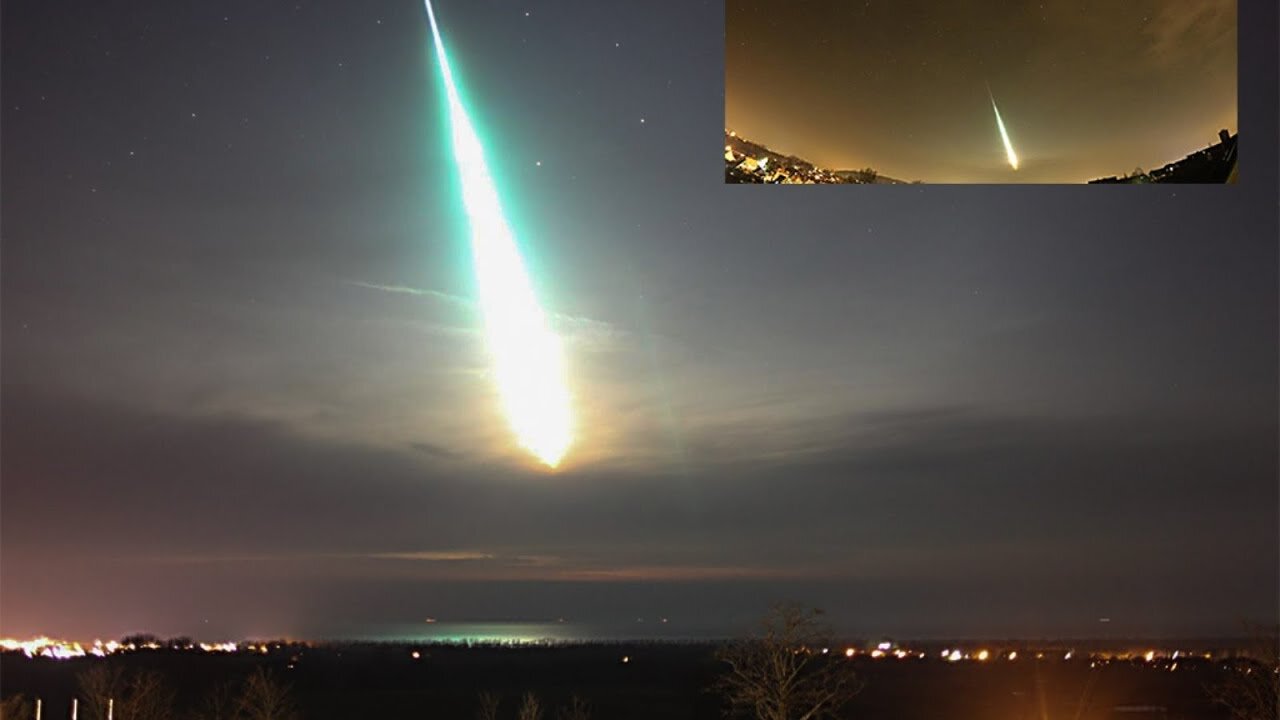Premium Only Content

TOP 5 METEORITE FALLS
Moon Crash (March 4, 2022) - https://bit.ly/44Ukv6A
Meteorite falls, also called observed falls, are meteorites collected after their fall from space was observed by people or automated devices. All other meteorites are called "finds". There are more than 1,100 documented falls listed in widely used databases, most of which have specimens in modern collections. As of early 2018, the Meteoritical Bulletin Database has 1,161 confirmed falls.
Observed meteorite falls are interesting for several reasons. Material from observed falls has not been subjected to terrestrial weathering, making the find a better candidate for scientific study. Historically, observed falls were the most compelling evidence supporting the extraterrestrial origin of meteorites. Furthermore, observed fall discoveries are a better representative sample of the types of meteorites which fall to Earth. For example, iron meteorites take much longer to weather and are easier to identify as unusual objects, as compared to other types. This may explain the increased proportion of iron meteorites among finds (6.7%), over that among observed falls (4.4%). There is also detailed statistics on falls such as based on meteorite classification. As of early 2018, the Meteoritical Bulletin Database has 1,161 confirmed falls with statistics for the previous decades in the table to the right. Specifically, confirmed falls were eight for 2015, eleven for 2016, and four so far for 2017.
The German physicist Ernst Cladni, sometimes considered as the father of meteoritics, was the first to publish (in 1794) the then audacious idea that meteorites were rocks from space. There were already several documented cases, one of the earliest was the Aegospotami meteorite of 467 BC and which became a landmark for 500 years.
While most confirmed falls involve masses between less than one kg to several kg, some reach 100 kg or more. A few are even more than one metric ton. The six largest falls are listed below and five (except the 2013 Chelyabinsk meteorite) occurred during the 20th century. Presumably, events of such magnitude may happen a few times per century but, especially if it occurred in remote areas, may have gone unreported. For comparison, the largest finds are the 60-ton Hoba meteorite, a 37-ton fragment (El Chaco) and a 30.8-ton fragment (Gancedo) of the Campo del Cielo, and a 30.9-ton fragment (Ahnighito) of the Cape York meteorite.
The Chelyabinsk meteor was a superbolide caused by an approximately 20-metre near-Earth asteroid that entered Earth's atmosphere over Russia on 15 February 2013 at about 09:20 YEKT (03:20 UTC), with a speed of 19.16 ± 0.15 kilometres per second (60,000–69,000 km/h or 40,000–42,900 mph). It quickly became a brilliant superbolide meteor over the southern Ural region. The light from the meteor was brighter than the Sun, visible up to 100 km (62 mi) away. It was observed over a wide area of the region and in neighbouring republics. Some eyewitnesses also felt intense heat from the fireball.
-
 UPCOMING
UPCOMING
Man in America
6 hours agoFort Knox & Trump’s Secret Gold Move—The Financial Reset NO ONE Is Ready For?
5.97K1 -
 LIVE
LIVE
Flyover Conservatives
20 hours agoIs America Following The Footsteps of The French Revolution? - President’s Day Special - Historian Bill Federer | FOC Show
690 watching -
 2:21:20
2:21:20
Robert Gouveia
3 hours agoTrump Goes to SCOTUS! Judge CAVES on DOGE? Fani Willis Not Happy!
41.8K11 -
 20:41
20:41
Stephen Gardner
3 hours ago🔥You Won't BELIEVE What JUST Happened To Don Trump Jr.!!
40.6K89 -
 UPCOMING
UPCOMING
Anthony Rogers
4 hours agoEpisode 354 - The Kala Method
34 -
 58:00
58:00
The StoneZONE with Roger Stone
1 hour agoEuropean Leaders Resist Trump Peace Overtures To Their Own Demise | The StoneZONE w/ Roger Stone
16.1K2 -
 9:29
9:29
AlaskanBallistics
3 hours ago $0.75 earnedWyoming Suppressors and Rifles at Shot Show 2025
17.9K2 -
 1:06:40
1:06:40
Donald Trump Jr.
7 hours agoThe Left is Taking one L After Another, Live with Michael Knowles | Triggered Ep. 217
110K88 -
 47:17
47:17
Kimberly Guilfoyle
7 hours agoWoke Gets DOGE’d, Live with AJ Rice & Jarrett Stepman | Ep. 197
82.6K32 -
 20:11
20:11
Candace Show Podcast
5 hours agoBecoming Brigitte: Candace Owens x Xavier Poussard | Ep 6
136K277